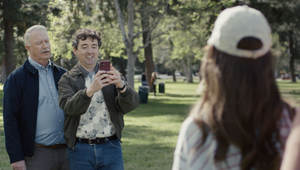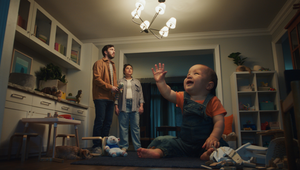
Finely Sliced: Watching the VFX Come to Life with Chancler Haynes

Early on in his career, Chancler's instinctive style quickly caught the eye of innovative filmmakers and was the foundation of years-long collaborative relationships with directors, such as Joseph Kahn and other established artists. With an undeniable ear for music, he has worked closely with Taylor Swift, Mariah Carey, Imagine Dragons, Maroon 5, Iggy Azalea to Jennifer Lopez and numerous others. This keen sense has led to incredible campaigns with Lexus, Fiat, Reebok, General Motors, Pepsi and many more and a two-time VMA nomination for “Best Editing” for his work with Taylor Swift. In addition, he has been recognised with a DayTime Emmy nomination for his work in 2017 with FoxSports and a VMA nomination for Best Editing in 2023.
Known by his colleagues as dependable, unabashedly positive, consistently humble and possessing an unrivalled “can-do” response to even the most laborious or complicated task, Chancler frequently finds new ways to use the tools in front of him (even using basic editorial software to do experimental visual transition work that leaves clients scratching their heads with a “how’d he do it?”) With an eye toward equity and inclusivity, Chancler is beloved amongst his many peers and a mentor to many young colleagues at Cosmo Street.
LBB> The first cut is the deepest: how do you like to start an editing project?
Chancler> I study the script and visualise what I want to see on screen. This is before I see anything that has been shot. Once that is embedded into my soul, I simply use the tools to make what I saw in my head, happen on the edit timeline. I let the footage guide me and tell me what needs to happen after that.
LBB> Non-editors often think of editing just in technical terms but it’s integral to the emotion and mood of a film. How did you develop that side of your craft?
Chancler> I have been obsessed with movies since I was at least five years old. That’s when I received my first Teenage Mutant Ninja Turtles movie on VHS. That’s my earliest memory of a visceral reaction to motion pictures, action and comedy all bundled into a wonderful visual and audio package. I knew nothing of the technical aspects that made these things happen. I just remember the way I felt the moment it hit me. And that feeling has never left. When I edit, I rely on those feelings to guide me in my editorial decisions. The technical tools are just a means to an end. If we all had to go back to splicing film together, so be it. Whatever it takes to get our visual story-telling on the screen.
LBB> How important is an understanding of story and the mechanics of story?
Chancler> I often enjoy reading the comments and discussion about weekly TV Series episodes, more than I enjoy watching the actual show. I love hearing what people respond to. And then I’ll watch that episode and study what it is that made them react in such a way. Every story should have fun and creative ways of shifting from their beginning, middle to the end. The same way a film's story should hook the audience from the start, an advertisement should find ways to lock into the view at the very first moments of viewing.
LBB> Rhythm and a sense of musicality seem to be intrinsic to good editing (even when it’s a film without actual music) – how do you think about the rhythm side of editing, how do you feel out the beats of a scene or a spot? And do you like to cut to music?
Chancler> Rhythmic editing is my favourite. I do like cutting to music. But I mostly enjoy making the subjects within the frame respond to the music. There’s also a musicality to dialog even more-so than instruments, so that is especially fun to cut. Rhythmic talking heads.
LBB> Tell us about a recent editing project that involved some interesting creative challenges.
Chancler> Speaking of musicality without music, in the film BODIED, we were tasked with making battle raps work without music, while also making them move with the intensity of a boxing match. Also, this was one of the many projects that I edited live on-set, with two or three cameras running. It was a very high speed challenge, but THE most fun. It was quite the active Avid project. Another challenge that I experienced recently was cutting a foreign language film from Iran during the tail end of the covid lockdown. I was the 2nd editor, picking up after the Iranian editor started the project. Most of the language translation and subtitles were already done, so that helped a ton. My task was mainly restructuring the story beats, cutting a few additional scenes, and sprucing up the action scenes. The greatest challenge was doing this all in Adobe Premiere. And finally, the most fun and exhilarating challenge of all was the feature film that we shot in Houston last summer. A film called ICK, Directed by my pal Joseph Kahn. Besides editing on-set in the thick July heat, we decided to edit this film in DaVinci Resolve Studio 18. This actually helped streamline a lot of the VFX needs. It also allowed a very seamless remote collaboration process once we wrapped the shoot. We were able to lock the edit about a week after the shoot.
LBB> In the US we know that editors are much more heavily involved across the post production process than in Europe - what’s your favourite part of that side of the job?
Chancler> I really enjoy seeing all of the VFX come to life after I have been living in the rough cut for so long. The more that I’m involved with the cutting in of VFX and seeing what the final outcome will be, the happier I am on the job.
LBB> What’s harder to cut around – too much material or not enough? (And why?)
Chancler> I much prefer too much footage, because there is no such thing. Not enough footage just means we have to start hitting the “wow” or “add dragons” button. When we need to start making something out of nothing, it does really show what you’re made of. So I guess I should say I love BOTH… right?
LBB> Which commercial projects are you proudest of and why?
Chancler> There’s a General Motors spot that ran during one of the Super Bowls and I really enjoyed playing with all of the possibilities in that campaign. It was directed by The Malloys. And shot by Rachel Morrison. This was brought to me by a good friend Chuck Meehan, and it is always a fun ride with Chuck in the edit. Also, I really had fun on Cadillac. Directed by Joseph Kahn and featuring one of my favourite physical performers of all time, Daniel Cloud Campos.
LBB> There are so many different platforms for film content now, and even in advertising something can last anything from a few seconds to a couple of hours. As an editor, are you seeing a change in the kind of projects you’re getting from brands and agencies?
Chancler> Yes, from TikTok, to YouTube brand short films, there are many different kinds of opportunities to tell stories. And I thank Cosmo Street for always finding those projects and putting them in front of me. It’s fun to go from a bunch of :30 second TVCs to a nice branded short film for YouTube. It really mixes things up. Work never gets boring. I love it.
LBB> Who are your editing heroes and why? What films or spots epitomise good editing for you?
Chancler> Besides the Jackie Chan and Spielberg movies that I watched throughout my entire youth, it was Joseph Kahn’s filmmaking that really made me zero in on how he told stories through his music videos. And once I saw his first studio feature film, TORQUE in 2004, after one of my troublesome days in film school, I gained a new cinematic energy and love for the craft. I’ve told Joseph this several times, so he knows the deal. His filmmaking made me who I am.
Also, my editing hero, mentor and friend Elísabet Ronaldsdóttir showed me very creative ways to make action sing on screen. The conversations that we’ve had about story structure, pacing, timing… It was worth three semesters at any film school. The fluidity in her cuts and scene transitions continue to inspire me. She’s the one who recommended me for my first action film, and I hope to follow up with more action movies in the future.
LBB> How does editing in the commercial world differ from the film world and TV world?
Chancler> That’s a really good question. I have only experienced the commercial world, with the opportunities to edit film and TV within this world. I imagine the only difference is how the jobs come to you. In my case, it’s based on filmmaker and agency relationships, as well as a really solid post house having your back. Film & TV studios probably share the same workflow from a technical standpoint. But with the indie film world, it can vary based on what the individual needs are. All of the films that I have done so far have all been independent with supreme love, help and support from my amazing family at Cosmo Street.
LBB> Have you noticed any trends or changes in commercial editing over recent years?
Chancler> What I have noticed is a rise in talent and ability to turn projects around a lot quicker. Which I think is great because it leaves room for more to be squeezed in. Commercials are a lot funnier these days too. I have been really excited to watch commercials more than the shows that are on. Let’s all keep the goods coming!















